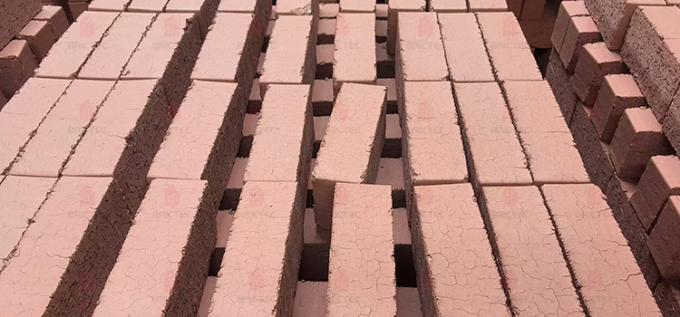Technical Analysis and Solution for Surface Cracks in Clay Fired Bricks
I. Problem Overview
The photo shows sintered clay bricks with visible surface cracking after firing. These cracks typically indicate internal stress imbalance or improper control during raw material preparation and kiln firing. Although the bricks may appear structurally complete, such cracks seriously affect the product’s mechanical strength, water absorption stability, and frost resistance — thus they are considered unqualified products in engineering applications.

II. Causes from Raw Material Perspective
1. Clay Plasticity and Shrinkage Imbalance
If the clay has excessively high plasticity or contains a large proportion of fine particles (<0.005 mm), the drying shrinkage becomes significant. During the drying and firing process, uneven shrinkage between layers leads to surface tension cracks.
Solution:
(1) Adjust the plastic index of the clay (16–25 is generally suitable).
(2) Add lean materials such as sand, shale powder, or fly ash to reduce shrinkage.
(3) Ensure the raw material particle size distribution is reasonable — a proper balance between coarse and fine fractions.
2. Improper Moisture Content During Forming
When the moisture content of the green bricks is too high (>20%), drying stress increases sharply, making the surface prone to cracking before firing.
Solution:
(1) Control extrusion water content within 16–18%.
(2) Use vacuum extrusion to remove air bubbles and achieve uniform density.
3. Inadequate Aging or Mixing
Insufficient blending or aging leads to uneven moisture and plasticity in the clay body, resulting in internal stress concentration during drying and firing.
Solution:
(1) Increase mixing and aging time (at least 48 hours for new clay).
(2) Ensure homogeneous blending of all additives and recycled materials.

III. Causes from Firing and Kiln Control Perspective
1. Rapid Drying or Heating
If the initial drying or preheating temperature rises too fast, the surface of the green brick dries and hardens quickly, forming a “shell,” while the interior still contains moisture. The steam pressure generated inside causes the surface to crack.
Solution:
(1) Slow down the drying curve; control the initial heating rate within 20–30°C/h.
(2) Extend the holding period in the drying zone to ensure even moisture removal.
2. Overly Fast Temperature Rise in the Sintering Zone
When the temperature in the firing zone increases sharply, especially between 600–900°C (dehydroxylation and quartz phase transformation stages), the brick body expands unevenly and cracks.
Solution:
(1) Optimize the firing curve and smooth the temperature rise.
(2) Keep the sintering zone temperature rise under 40°C/h through the quartz inversion phase.
3. Improper Cooling Rate
If cooling after sintering is too rapid, thermal shock causes cracks, especially for thick or dense products.
Solution:
(1) Control the cooling rate below 40°C/h from 900°C to 600°C.
(2) Ensure the cooling air flow is even to avoid local thermal stress.
IV. Process Optimization and Quality Control Recommendations
1. Raw Material Testing: Regularly test plasticity index, drying shrinkage, and mineral composition of the clay.
2. Forming Process: Ensure uniform extrusion pressure and avoid lamination defects.
3. Drying Control: Use staged drying with automatic temperature and humidity adjustment.
4. Kiln Operation: Monitor temperature curves and air distribution in real time; use infrared or thermocouple sensors.
5. Post-Firing Inspection: Observe crack patterns — mesh-like cracks usually indicate shrinkage imbalance, while single long cracks often point to thermal stress.

V. Brictec Conclusion
1. Surface cracking in fired clay bricks is a result of combined effects of raw material composition, forming moisture, and firing regime.
2. By optimizing clay blending, strictly controlling drying and firing curves, and improving temperature uniformity in the tunnel kiln, such defects can be effectively prevented.
3. Through systematic process control, Brictec ensures that clay sintered bricks achieve dense texture, uniform color, and excellent mechanical properties, meeting high-end architectural and structural standards.
Editor: JF & Lou

 پیام شما باید بین 20 تا 3000 کاراکتر باشد!
پیام شما باید بین 20 تا 3000 کاراکتر باشد! لطفا ایمیل خود را چک کنید!
لطفا ایمیل خود را چک کنید!  پیام شما باید بین 20 تا 3000 کاراکتر باشد!
پیام شما باید بین 20 تا 3000 کاراکتر باشد! لطفا ایمیل خود را چک کنید!
لطفا ایمیل خود را چک کنید! 




